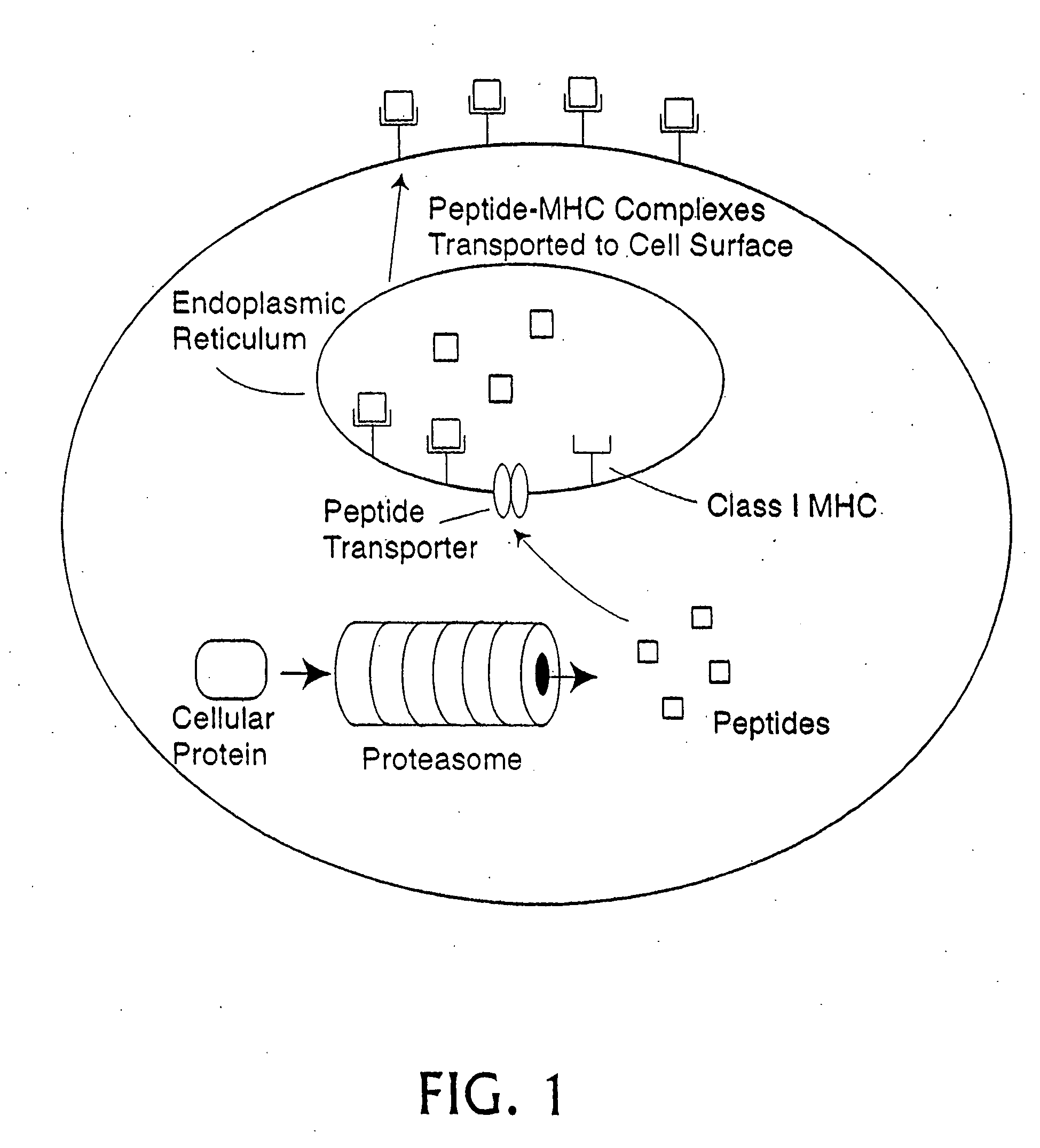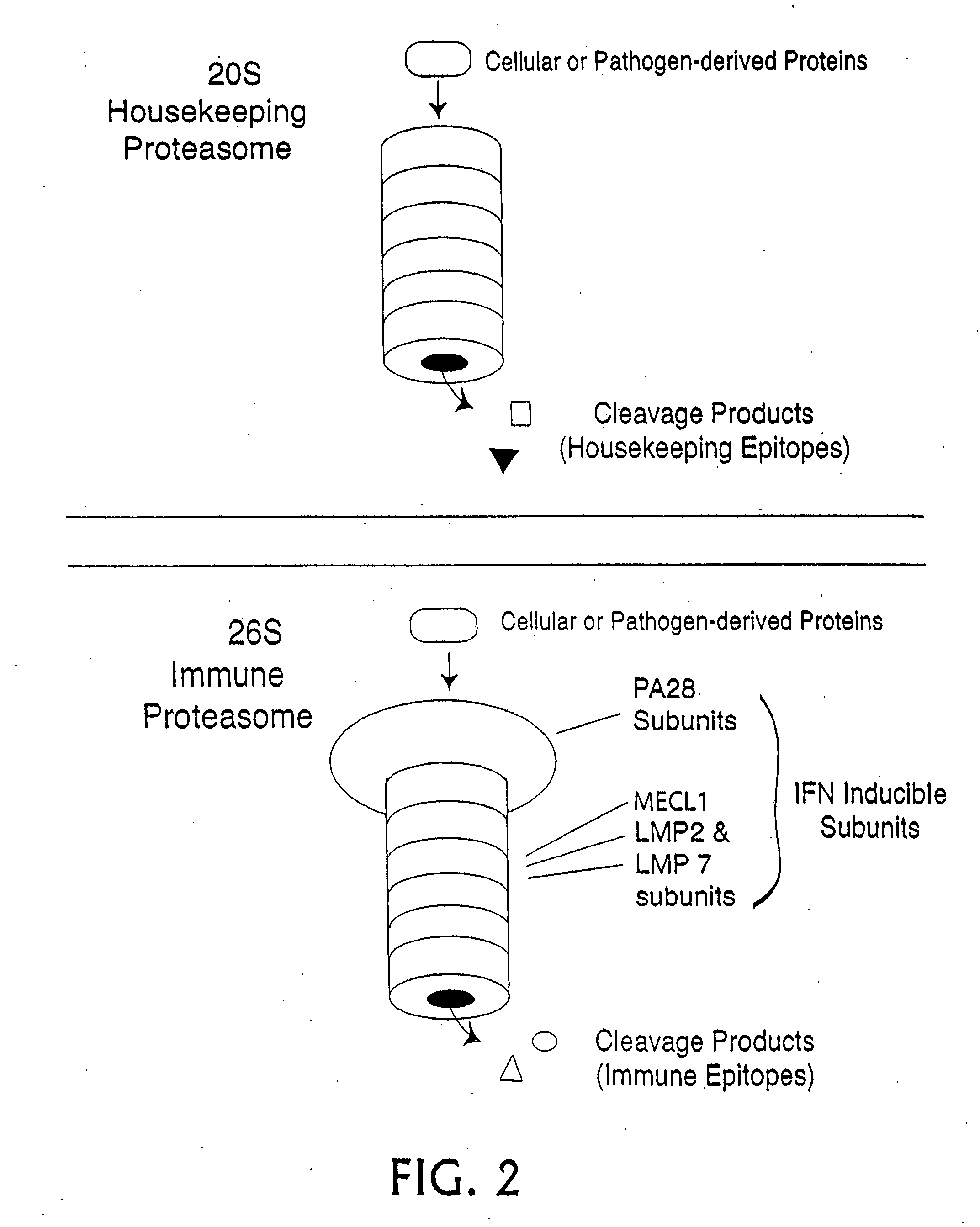Epitope synchronization in antigen presenting cells
a technology of antigen presenting cells and epitopes, which is applied in the direction of dna/rna vaccination, antibody medical ingredients, chairs, etc., can solve the problems of evading the immune system of the host, unable to select and effectively administer minimal epitopes for use as viral vaccines, and unable to meet the needs of the host, so as to facilitate the acceptance of such vaccines, stimulate the discovery and clinical development of effective vaccines, and enhance the demand of vaccines
- Summary
- Abstract
- Description
- Claims
- Application Information
AI Technical Summary
Benefits of technology
Problems solved by technology
Method used
Image
Examples
example 1
Proteolytic Characterization of an HLA Epitope as a Housekeeping Epitope or an Immune Epitope
[0352] Using the procedures described below, a synthetic peptide of 13 amino acids or more is prepared, containing the candidate HLA epitope centrally. Proteasomes are prepared from cells expressing each type of proteasome, for example red blood cells and Raji cells for housekeeping and immune proteasomes, respectively. The peptide is digested with the proteasome preparations and the resultant fragments identified by mass spectrometry. If one of those fragments is co-C-terminal with the HLA epitope, and is produced in significant yield in the preparation containing a housekeeping proteasome, then the HLA epitope is a housekeeping epitope. Similarly, if one of those fragments is co-C-terminal with the HLA epitope and is produced in significant yield by the immune proteasome, and is not produced in significant yield by the housekeeping proteasome, then the HLA epitope is a immune epitope.
A....
example 2
Purification of Proteasome Complexes
A. Proteasome Complexes from Blood Cells
[0363] Concentrated erythrocyte bags were obtained from a local blood bank, (HemaCare, Van Nuys, Calif.). The contents of each bag were poured into 200 ml centrifuge tubes and washed 3 times with PBS by centrifugation at 2000 RPM for 10 minutes at room temperature in a swinging bucket rotor of a Megafuge 2.0 (Heraeus, Southplainfield, N.J.). After the last wash the samples were pooled in one container, to minimize variability among tubes, and then re-divided into several centrifuge tubes. The cells were centrifuged again at 2000 RPM for 10 min. The residual PBS was aspirated. The pellet was stored at −70° C. until use.
B. Proteasome Complexes from Tumor Cells
[0364] Raji cells, a Burkitt's lymphoma cell line, were obtained from ATCC, (American Type Culture Collection, Manassas, Va.). The cells were grown using standard cell culture methods and stimulated with INF-Gamma (100-500 U / ml) (Pharmingen, San Die...
example 3
Generation of Predicted MHC I Peptide Cleft Binding Peptides Using Algorithmic Modeling
[0370] A population of candidate MHC I binding peptides, generated from the amino acid sequence of human carcinoembryonic antigen precursor (CEA) (GENBANK ACCESSION P06731), was produced using an algorithm. The particular algorithm is available at >, as discussed above. Once the algorithm was accessed, the amino acid sequence for CEA was provided. Next, parameters for the length of the epitope (decamers) and the particular MHC allele (H2-Db) of interest were selected. Following this, the data were submitted for algorithmic analysis. The resulting data are shown in Table 9.
TABLE 9Fragments of CEA having PredictedAffinity for H2-DbPOS1 2 3 4 5 6 7 8 9 0ScoreSeq id no547L Q L S N G N R T L2628369L Q L S N D N R T L2629191L Q L S N G N R T L263053L L V H N L P Q H L2631371L S N D N R T L T L2532549L S N G N R T L T L2433193L S N G N R T L T L2434299C Q A H N S D T G L2335100I I Y P N A S L L I21365...
PUM
| Property | Measurement | Unit |
|---|---|---|
| composition | aaaaa | aaaaa |
| binding affinity | aaaaa | aaaaa |
| cell surface | aaaaa | aaaaa |
Abstract
Description
Claims
Application Information
 Login to View More
Login to View More - R&D
- Intellectual Property
- Life Sciences
- Materials
- Tech Scout
- Unparalleled Data Quality
- Higher Quality Content
- 60% Fewer Hallucinations
Browse by: Latest US Patents, China's latest patents, Technical Efficacy Thesaurus, Application Domain, Technology Topic, Popular Technical Reports.
© 2025 PatSnap. All rights reserved.Legal|Privacy policy|Modern Slavery Act Transparency Statement|Sitemap|About US| Contact US: help@patsnap.com



